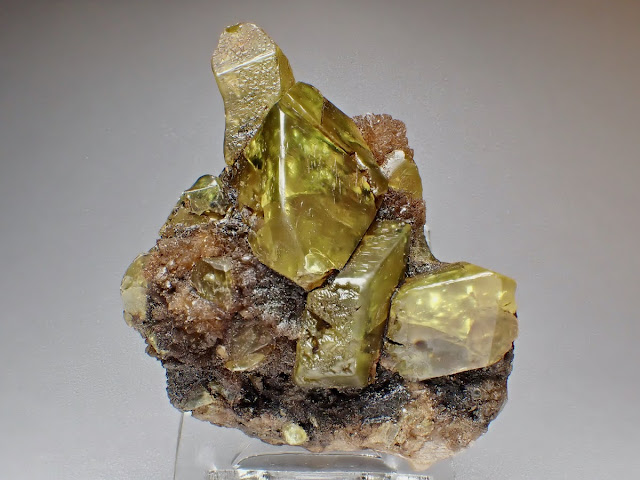シチリアの蝕像硫黄 Sulfur from Sicily with etch figure
標本幅 width 5.5 cm / 重さ weight 123 g
シチリア島アグリジェントは古来硫黄の産地として知られ、古典標本として世界中の博物館に収められている。大正7年(1918年)刊の佐藤伝蔵「大鉱物学・下巻」(六盟館)にも「(硫黄の)結晶はシシリー島のシアンシアナ Cianciana の上部中新統の含石膏泥灰岩中より出づるものを最も美麗とす。多く天青石と伴うて出づ」とある。堀秀道「楽しい鉱物図鑑」(草思社、1993)にもここの標本が紹介されている。
Agrigento in Sicily island is such a well known locality of sulfur that specimens from there are displayed at museums in the world. An old textbook of mineralogy written by Sato Denzo in 1918 reads that the most beautiful sulfur crystals are from the upper Miocene marlstone in Cianciana, Sicily, often occurring with celestine. Hori Hidemichi's book also used a picture of Agrigento sulfur as a representative specimen.
黒くみえるのはピッチ質の有機物で、堀の図鑑にも書かれているとおり硫黄晶出の過程でバクテリアが関与したことと関係するらしい。鼻を近づけると強い瀝青臭(アスファルト臭)がする。こういう感覚は標本を実際に手にしないと味わえない。わが家の標本棚には硫化鉱物が多くてもともと「臭い」のだが、この硫黄標本の臭さは飛び抜けているのでアクリルケースに密封して陳列している。共生する白っぽい鉱物は mindat.org の同産地の類似標本の解説を参照すれば霰石かもしれない。紫外線長波のもとでピンク色に蛍光する。
This specimen is covered by black bitumen (pitch-like organic substance), implying that bacteria played a role in sulfur crystalization as Hori described in his book. It smells strongly, which cannot be felt unless having a specimen at hand. So, this is encased in a plastic box in my showcase, which is full of sulfide minerals and already smelling. The co-occurring white mineral is probably aragonite according to description of other examples in mindat.org. It becomes pink under long-wave UV light.
There are a number of triangular pits in parallel.
硫黄の結晶面上に小さな三角形のくぼみが規則正しく並んでいるところがある。これは天然の蝕像であろう。一般に鉱物の表面を酸などで腐食させるとこうした規則正しいくぼみがあらわれることがあり、蝕像(あるいは蝕丘)という(くわしくは前掲の佐藤「大鉱物学」の上巻を参照)。この標本の場合、一度結晶が成長したあとなんらかの作用で表面が溶けたのだろう(そもそも結晶全体が丸みを帯びている)。分析技術が未熟だった19世紀の鉱物学ではこうした原始的ともいえる方法で結晶の構造や対称性をしらべた。現代の鉱物学で蝕像がどの程度の重要度をもつのか定かでないが、やろうと思えば(強酸の入手が必要だが)しろうとでもできる、有用な分析手法とおもわれる。
Natural etch figures can be seen on the sulfur crystal surfaces. The rounded crystal shape implies a dissolving process occurred after crystalization.
Sato Denzo, Dai-Kobutsu-Gaku (The great mineralogy), published from Rokumeikan in 1918.



